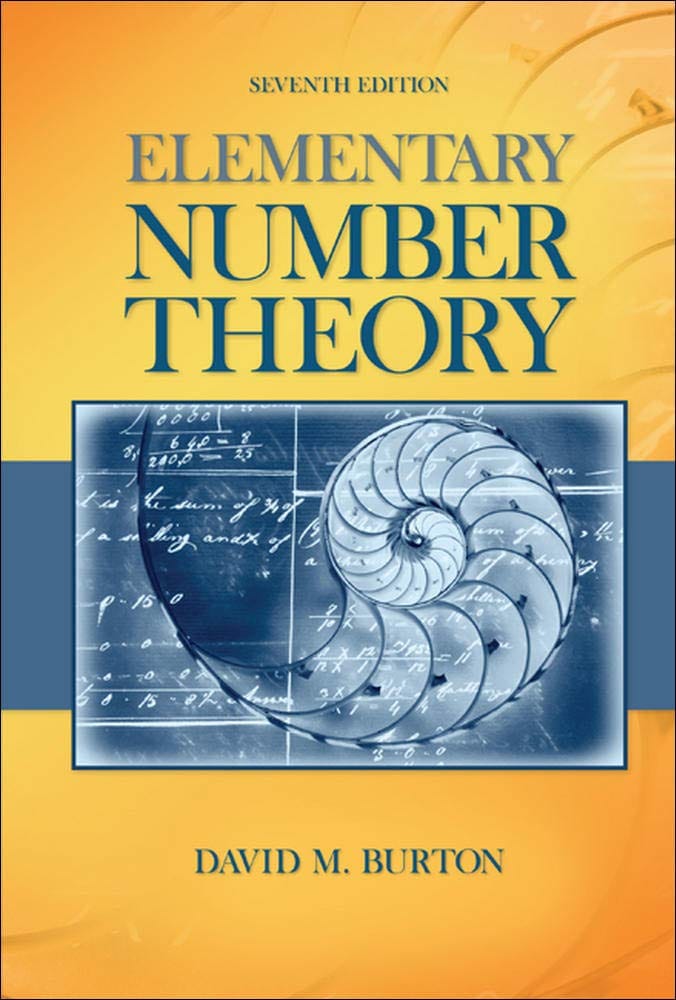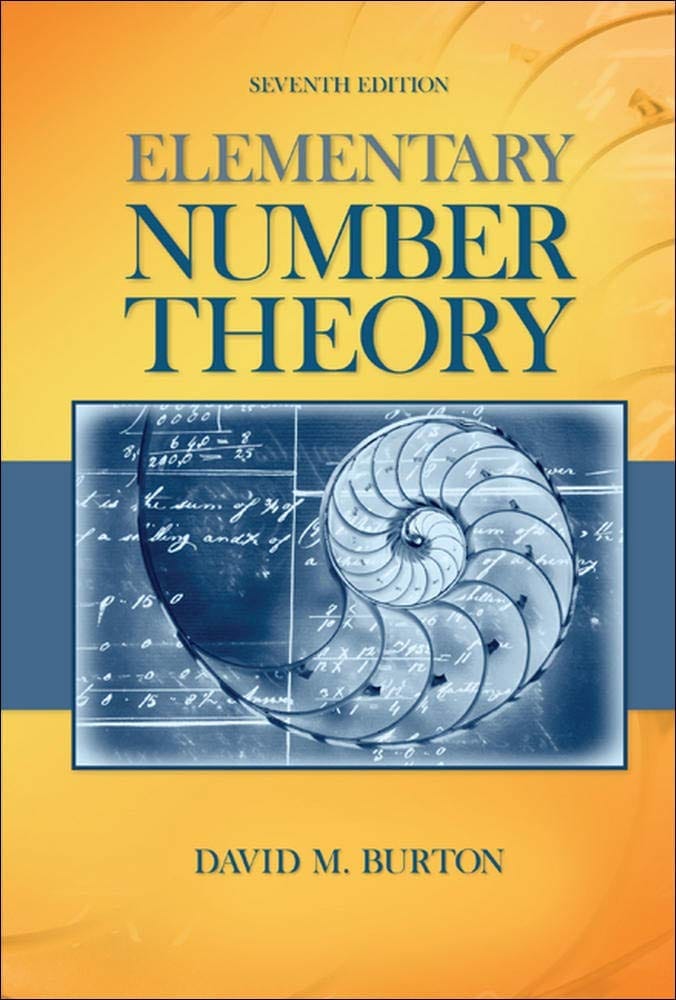
Elementary Number Theory Problems 3.3 Solution (David M. Burton's 7th Edition)
My solutions for Burton's Elementary Number Theory Problems 3.3 (7th Edition)
Table of Contents
Background
These are my solutions while I was studying number theory using this book. I will use the theorems and definitions mentioned in the book.
If you don't have the book or are unsure which theorem or definition I am using here, you can check out this article, where I listed all theorems, corollaries, and definitions by following the book's order.

If you haven't heard of this book and are interested in learning number theory, I strongly recommend it since it is quite friendly for beginners. You can check out the book by this link:

I will only use theorems or facts that are proved before this chapter. So, you will not see that I quote theorems or facts from the later chapters.
All Problems in 3.2 (p. 49 - p. 50)
Q1
Verify that the integers $1949$ and $1951$ are twin primes.
Q2
(a) If $1$ is added to a product of twin primes, prove that a perfect square is always obtained.
(b) Show that the sum of twin primes $p$ and $p + 2$ is divisible by $12$, provided that $p > 3$.
Q3
Find all pairs of primes $p$ and $q$ satisfying $p - q = 3$.
Q4
Sylvester ($1896$) rephrased the Goldbach conjecture: Every even integer $2n$ greater than $4$ is the sum of two primes, one larger than $n/2$ and the other less than $3n/2$. Verify this version of the conjecture for all even integers between $6$ and $76$.
Q5
In 1752, Goldbach submitted the following conjecture to Euler: Every odd integer can be written in the form $p + 2a^2$, where $p$ is either a prime or $1$ and $a \geq 0$. Show that the integer $5777$ refutes this conjecture.
Q6
Prove that the Goldbach conjecture that every even integer greater than $2$ is the sum of two primes is equivalent to the statement that every integer greater than $5$ is the sum of three primes.
[Hint: If $2n - 2 =p_{1}+ p_{2}$, then $2n =p_{1}+ p_{2} + 2$ and $2n + 1 =p_{1}+ p_{2} + 3$.]
Q7
A conjecture of Lagrange ($1775$) asserts that every odd integer greater than $5$ can be written as a sum $p_{1} + 2p_{2}$, where $p_{1}$, $p_{2}$ are both primes. Confirm this for all odd integers through $75$.
Q8
Given a positive integer $n$, it can be shown that there exists an even integer $a$ that is representable as the sum of two odd primes in $n$ different ways. Confirm that the integers $60$, $78$, and $84$ can be written as the sum of two primes in six, seven, and eight ways, respectively.
Q9
(a) For $n > 3$, show that the integers $n$, $n + 2$, $n + 4$ cannot all be prime.
(b) Three integers $p$, $p + 2$, $p + 6$, which are all prime, are called a $\textit{prime-triplet}$. Find five sets of prime-triplets.
Q10
Establish that the sequence $$(n + 1)! - 2, (n + 1)! - 3, ... , (n + 1)! - (n + 1)$$ produces $n$ consecutive composite integers for $n > 2$.
Q11
Find the smallest positive integer $n$ for which the function $f(n) = n^2 + n + 17$ is composite. Do the same for the functions $g(n) = n^2 + 21n + 1$ and $h(n) = 3n^2 + 3n + 23$.
Q12
Let $p_{n}$ denote the $n$th prime number. For $n \geq 3$, prove that $p_{n+3}^{2} < p_{n}p_{n+1}p_{n+2}$.
[Hint: Note that $p_{n+3}^{2} < 4p_{n+2}^2 <8p_{n+1}p_{n+2}$.]
Q13
Apply the same method of proof as in Theorem 3.6 to show that there are infinitely many primes of the form $6n + 5$.
Q14
Find a prime divisor of the integer $N = 4(3 \cdot 7 \cdot 11) - 1$ of the form $4n + 3$. Do the same for $N = 4(3 \cdot 7 \cdot 11 \cdot 15) - 1$.
Q15
Another unanswered question is whether there exists an infinite number of sets of five consecutive odd integers of which four are primes. Find five such sets of integers.
Q16
Let the sequence of primes, with $1$ adjoined, be denoted by $p_{0} = 1, p_{1} = 2, p_{2} = 3, p_{3} = 5, ....$ For each $n \geq 1$, it is known that there exists a suitable choice of coefficients $\epsilon_{k} = \pm 1$ such that
$$ \begin{equation} \begin{split} p_{2n} = p_{2n - 1} + \sum_{k = 0}^{2n - 2} \epsilon_{k}p_{k} \qquad p_{2n + 1} = 2p_{2n} + \sum_{k = 0}^{2n - 1} \epsilon_{k}p_{k} \end{split} \nonumber \end{equation} $$To illustrate:
$$ 13 = 1 + 2 - 3 - 5 + 7 + 11 $$and
$$ 17 = 1 + 2 - 3 - 5 + 7 - 11 + 2 \cdot 13 $$Determine similar representations for the primes $23, 29, 31,$ and $37$.
Q17
In $1848$, de Polignac claimed that every odd integer is the sum of a prime and a power of $2$. For example, $55 = 47 + 2^{3} = 23 + 2^{5}$. Show that the integers $509$ and $877$ discredit this claim.
Q18
(a) If $p$ is a prime and $p \not \mid b$, prove that in the arithmetic progression $$a, a + b, a + 2b, a + 3b, ...$$ every $pth$ term is divisible by $p$.
[Hint: Because $gcd(p, b) = 1$, there exist integers $r$ and $s$ satisfying $pr+ bs = 1$.
Put $n_{k} = kp - as$ for $k= 1, 2, ...$ and show that $p \mid (a+ n_{k}b)$.]
(b) From part (a), conclude that if $b$ is an odd integer, then every other term in the indicated progression is even.
Q19
In $1950$, it was proved that any integer $n > 9$ can be written as a sum of distinct odd primes. Express the integers $25$, $69$, $81$, and $125$ in this fashion.
Q20
If $p$ and $p^{2} + 8$ are both prime numbers, prove that $p^{3} + 4$ is also prime.
Q21
(a) For any integer $k > 0$, establish that the arithmetic progression $$a + b, a + 2b, a + 3b, ...$$ where $gcd(a, b) = 1$, contains $k$ consecutive terms that are composite.
[Hint: Put $n =(a+ b)(a + 2b) \cdots (a+ kb)$ and consider the $k$ terms $a+ (n + 1)b, a+ (n + 2)b, ... , a+ (n + k)b$.]
(b) Find five consecutive composite terms in the arithmetic progression $$6, 11, 16,21,26,31,36, ...$$
Q22
Show that $13$ is the largest prime that can divide two successive integers of the form $n^{2} + 3$.
Q23
(a) The arithmetic mean of the twin primes $5$ and $7$ is the triangular number $6$. Are there any other twin primes with a triangular mean?
(b) The arithmetic mean of the twin primes $3$ and $5$ is the perfect square $4$. Are there any other twin primes with a square mean?
Q24
Determine all twin primes $p$ and $q = p + 2$ for which $pq - 2$ is also prime.
Q25
Let $p_{n}$ denote the $n$th prime. For $n > 3$, show that $$p_{n} < p_{1} + p_{2} + \cdots + p_{n-1}$$
[Hint: Use induction and the Bertrand conjecture.]
Q26
Verify the following:
(a) There exist infinitely many primes ending in $33$, such as $233$, $433$, $733$, $1033, ....$
[Hint: Apply Dirichlet's theorem.]
(b) There exist infinitely many primes that do not belong to any pair of twin primes.
[Hint: Consider the arithmetic progression $21k + 5$ for $k= 1, 2, ....$ ]
(c) There exists a prime ending in as many consecutive $1$'s as desired.
[Hint: To obtain a prime ending in $n$ consecutive $1$'s, consider the arithmetic progression $10^{n}k +R_{n}$ for $k= 1, 2, ....$ ]
(d) There exist infinitely many primes that contain but do not end in the block of digits $123456789$.
[Hint: Consider the arithmetic progression $10^{n}k + 1234567891$ for $k= 1, 2, ....$]
Q27
Prove that for every $n \geq 2$ there exists a prime $p$ with $p \leq n < 2p$.
[Hint: In the case where $n = 2k + 1$, then by the Bertrand conjecture there exists a prime $p$ such that $k < p < 2k$.]
Q28
(a) If $n > 1$, show that $n!$ is never a perfect square.
(b) Find the values of $n \geq 1$ for which $$n! + (n + 1)! + (n + 2)!$$ is a perfect square.
[Hint: Note that $n! + (n + 1)! + (n + 2)! = n!(n + 2)^{2}$ .]
Ranblog Newsletter
Join the newsletter to receive the latest updates in your inbox.


